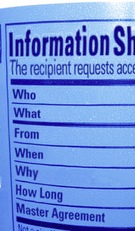According to The Cost of Reading Privacy Policies, a paper by Aleecia M. McDonald and  Lorrie Faith Cranor of Carnegie Mellon University, “national opportunity cost for just the time to read policies is on the order of $781 billion.”
Lorrie Faith Cranor of Carnegie Mellon University, “national opportunity cost for just the time to read policies is on the order of $781 billion.”
This is based on reading 1462 policies with a median length of 2518 words, taking about ten minutes per policies, adding up to 76 work days per year, or a total of 53.8 billion hours for the U.S. population reading those polcies. This number, observes Alexis Madrigal, senior editor of The Atlantic, exceeds the GDP of Florida.
So, Joe Andrieu and Iain Henderson think, why not eliminate the cost of that work by adopting a Standard Information Sharing Label — like the nutrition label you see on foods of all kinds? So they’ve started a Kickstarter project to do exactly that. Their funding goal, $12,500, is, by my calculations, 1/00000001600512th of the opportunity costs we already run up every year.
Joe and Iain are already quite a bit downstream, having worked for some time on the Information Sharing Workgroup at Kantara, where they are already underway with a draft specification for the label.
So give the a hand, in the form of a pledge.
Leave a Reply